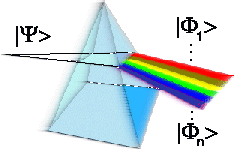Phys. Rev. E 59, 3655 (1999)
Marian Rusek and Arkadiusz Orłowski
Anderson localization of electromagnetic waves in random arrays of dielectric cylinders confined within a planar metallic waveguide is studied. The disordered dielectric medium is modeled by a system of randomly distributed two-dimensional electric dipoles. An effective theoretical approach based on the method of images is developed. A clear distinction between isolated localized waves (which exist already in finite media) and the band of localized waves (which appears only in the limit of the infinite medium) is presented. The Anderson localization emerging in the limit of an infinite medium is observed both in finite-size scaling analysis of transmission and in the properties of the spectra of some random matrices.
May 29, 1998
Wehrl's entropy and classification of states
Rep. Math. Phys. 43, 283 (1999)
A. Orłowski
The usefulness of Wehrl's entropy in quantum optics is investigated. Possible applications to the classification of quantum states with respect to their statistical properties are presented. A general variational proof of the observation that for a given average photon number the maximum Wehrl's entropy is attained for thermal states is given.
A. Orłowski
The usefulness of Wehrl's entropy in quantum optics is investigated. Possible applications to the classification of quantum states with respect to their statistical properties are presented. A general variational proof of the observation that for a given average photon number the maximum Wehrl's entropy is attained for thermal states is given.
Mar 18, 1998
Changes of the electrokinetic effects induced by guided light in capillary electrophoresis
Electrophoresis 20, 2493-2500 (1999)
Leonardo De Boni, Lilian T. C. França, Hans-Peter H. Grieneisen, Maciej Janowicz, Tarso B. L. Kist, Angelica R. Consiglio, Júlio R. Schoffen, Valter Stefani, Carlos Termignoni
The phenomenon of electrophoresis in free solution has been studied theoretically down to the molecular level for decades. In addition, intermolecular photo-induced proton transfer reactions, which occur in a wide class of molecules (phenols and aminoarenes) as well as proteins (green fluorescent protein), were also studied extensively. However, the study of the effect of light-induced electrophoretic mobility changes of the analytes in electrophoresis was begun only recently. In the present work, capillary zone electrophoresis was chosen as the environment to measure the magnitude of these electrophoretic mobility shifts induced by light. Background electrolytes (running electrolytes) with high refractive indices were developed, allowing the capillary to work like an optical fiber. The experimental conditions for obtaining stable coupling and guided laser light along the liquid core are discussed. Experimental evidence of band compression is observed, leading to a solitary wave behavior of the analyte band (2-naphthol). These solitary waves result from competition between thermal diffusion (dispersion mechanism) and a nonlinear (band compression) effect due to the combined electrophoresis phenomenon and absorption of guided light by the molecules of the band (which are subjected to a reversible intermolecular proton transfer reaction as one of their decay routes). The possibilities of applying this effect to different methods and techniques are also discussed.
Leonardo De Boni, Lilian T. C. França, Hans-Peter H. Grieneisen, Maciej Janowicz, Tarso B. L. Kist, Angelica R. Consiglio, Júlio R. Schoffen, Valter Stefani, Carlos Termignoni
The phenomenon of electrophoresis in free solution has been studied theoretically down to the molecular level for decades. In addition, intermolecular photo-induced proton transfer reactions, which occur in a wide class of molecules (phenols and aminoarenes) as well as proteins (green fluorescent protein), were also studied extensively. However, the study of the effect of light-induced electrophoretic mobility changes of the analytes in electrophoresis was begun only recently. In the present work, capillary zone electrophoresis was chosen as the environment to measure the magnitude of these electrophoretic mobility shifts induced by light. Background electrolytes (running electrolytes) with high refractive indices were developed, allowing the capillary to work like an optical fiber. The experimental conditions for obtaining stable coupling and guided laser light along the liquid core are discussed. Experimental evidence of band compression is observed, leading to a solitary wave behavior of the analyte band (2-naphthol). These solitary waves result from competition between thermal diffusion (dispersion mechanism) and a nonlinear (band compression) effect due to the combined electrophoresis phenomenon and absorption of guided light by the molecules of the band (which are subjected to a reversible intermolecular proton transfer reaction as one of their decay routes). The possibilities of applying this effect to different methods and techniques are also discussed.
Subscribe to:
Comments (Atom)
